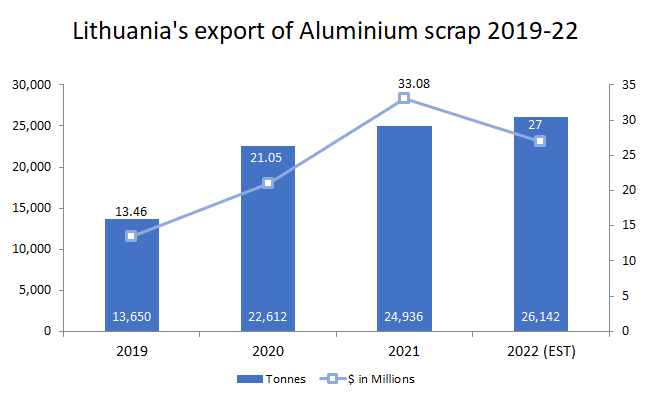

Aluminium scrap is generally categorized as either "new scrap" from production processes or "old scrap" from post-consumer use. In manufacturing aluminium semi-fabricated and final products, new scrap is generated. Those products collected after consumers have disposed of them are considered old scrap. It is common for old scrap to be more contaminated than new scrap. Vehicles that have reached the end of their useful lives, demolished buildings and constructions, packaging materials that have been discarded, home and office appliances, as well as machinery equipment, can all provide old aluminium scrap.

Following a 5.0% expansion in 2021, Lithuania's economy is expected to expand by 1.9% in 2022, a moderate increase over the 1.7% forecast in spring, resulting from a better-than-expected quarter for exports. It is also expected to grow by 2.5% in 2023.
The nation in the Baltic region of Europe, Lithuania's aluminium scrap export during 2019-21was recorded at 61,198 tonnes which incurred revenue earnings of around $67.59 million. In 2019, Lithuania exported 13,650 tonnes of aluminium scrap, accounting for earnings of $13.46 million. In 2020, the aluminium scraps export unveiled a growth of 65.65%, as the export volume surged to 22,612 tonnes and earnings soared to $21.05 million.
Lithuania's export of aluminium scraps in 2021 was recorded at 24,936 tonnes, depicting a growth of 10.27%, and earnings escalated to $33.08 million.
The scraps export for 2022 is analyzed with a further rise of 4.83%, as the export volume is anticipated to augment at 26,142 tonnes, while earnings to stay back at $27 million.
The major trading destinations for Lithuania's export of aluminium scrap are Austria, China, Denmark, Finland, India, Germany, Latvia, Malaysia, Slovakia, Poland, Thailand, etc.
Responses








